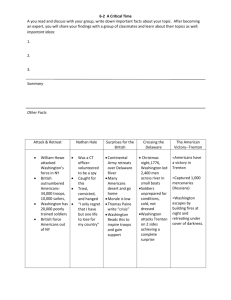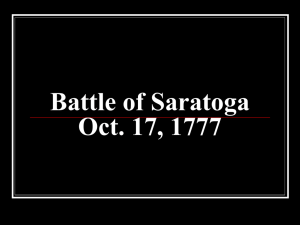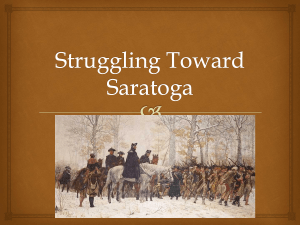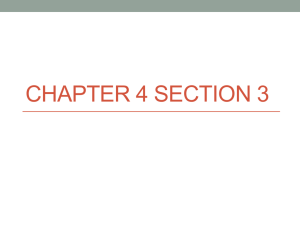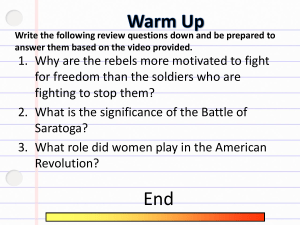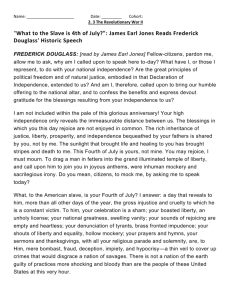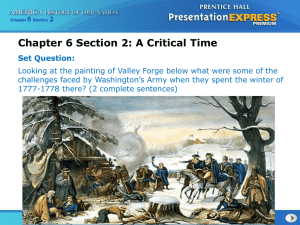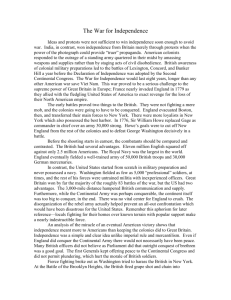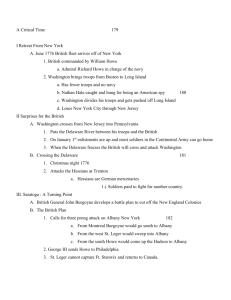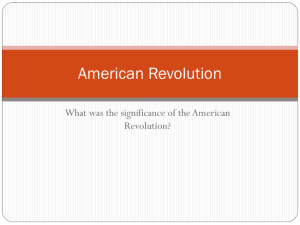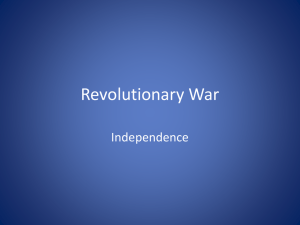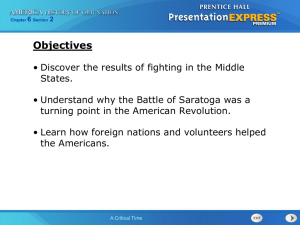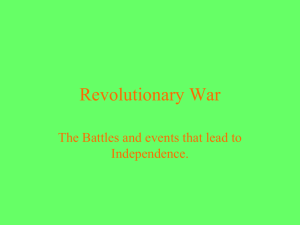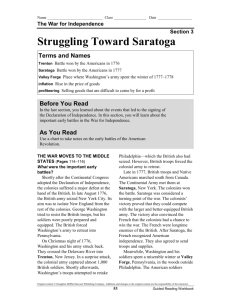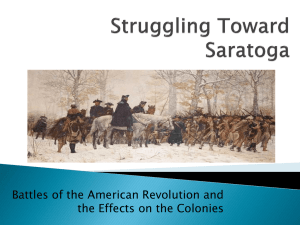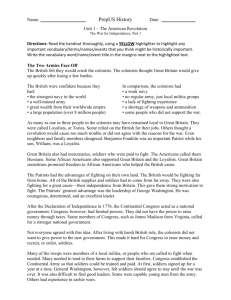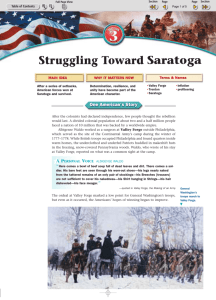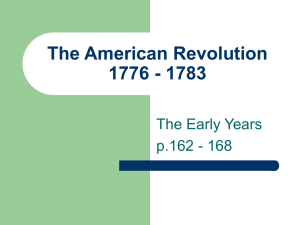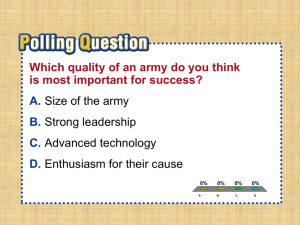Chapter 6 – Section 2
advertisement
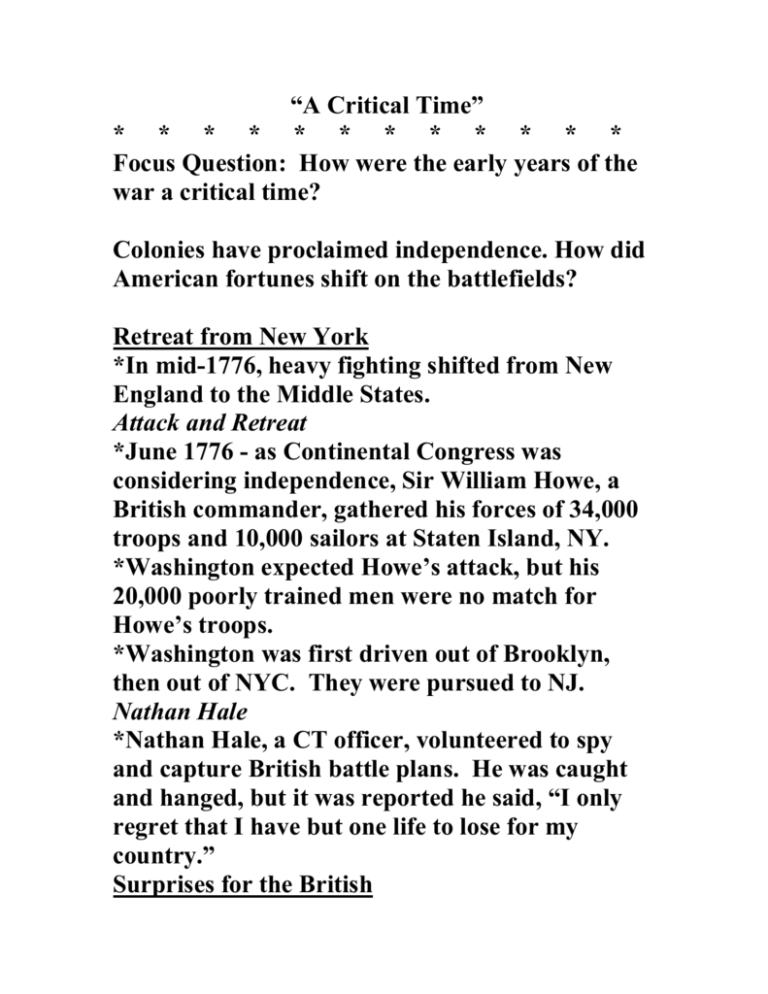
“A Critical Time” * * * * * * * * * * * * Focus Question: How were the early years of the war a critical time? Colonies have proclaimed independence. How did American fortunes shift on the battlefields? Retreat from New York *In mid-1776, heavy fighting shifted from New England to the Middle States. Attack and Retreat *June 1776 - as Continental Congress was considering independence, Sir William Howe, a British commander, gathered his forces of 34,000 troops and 10,000 sailors at Staten Island, NY. *Washington expected Howe’s attack, but his 20,000 poorly trained men were no match for Howe’s troops. *Washington was first driven out of Brooklyn, then out of NYC. They were pursued to NJ. Nathan Hale *Nathan Hale, a CT officer, volunteered to spy and capture British battle plans. He was caught and hanged, but it was reported he said, “I only regret that I have but one life to lose for my country.” Surprises for the British *Continental Army kept retreating under British pursuit. *December - army pushed into Pennsylvania. *Patriot spirits low, many deserted army. *To raise morale, Thomas Paine wrote The Crisis, a pamphlet urging Americans to support their army, which Washington had read aloud to his troops. Crossing the Delaware *Christmas night, 1776 - Washington led his men across the Delaware River on small boats to attack Trenton, NJ. *Washington’s soldiers were so poorly supplied that they often had no shoes (tied rags to feet). *The soldiers in Trenton were hired mercenaries (soldiers who are paid to fight for a country other than there own). An American Victory *Hessians (German mercenaries fighting for British) had been sleeping off a Christmas celebration when Washington’s men surprised them and captured almost a thousand men, assuring a decisive victory. *Washington’s men escaped the British by escaping during the night while their fires burned tricking the British into thinking they were still there. Attacked British near Princeton. Saratoga: A Turning Point *British General John Burgoyne plan – cutting New England off from the rest of the states. The British Plan *Burgoyne’s attack near Albany, NY, came from three directions: ~From Canada – Burgoyne leads an army of 8,000 south to Lake Champlain, Lake George, and upper Hudson River. ~From the west – St. Leger‘s smaller force would move toward Albany through Mohawk Valley ~From the south – Howe would lead a large army north up Hudson River from NYC. *The plan failed. ~Howe was ordered to move further south by the king to try to capture Washington. ~Burgoyne took his time and rewarded his men with celebrations instead of driving forward ~St. Leger was tricked by a false piece of leaked information saying his troops would be outnumbered and retreated. An American Victory *Burgoyne’s troops encountered American troops near Saratoga, NY. American leaders Benedict Arnold and Horatio Gates commanded the Americans. Arnold’s men attacked repeatedly near Freeman’s Farm inflicting heavy casualties on the British. Gates’ men attacked from behind earthen walls. *Eventually Burgoyne suffered too many casualties and was forced to retreat. Results of the Battle *The Battles of Saratoga had two consequences. 1 - Benedict Arnold, recovering from wounds, was swayed to believe in the Loyalist cause by a woman caring for him who would become his wife. He would attempt to turn over an American fort to the British but the plan was discovered and he escaped capture. 2 - It was a turning point in the war since it caused European countries to believe Americans might win and it lifted American spirits. Help from Overseas *Soon after Saratoga, France agreed to support American independence. *Feb. 18, 1778 - Alliance with France (a formal agreement between two powers to work together toward a common goal) formed. The French Alliance *Alliance came from a desire by France to weaken Britain (enemy – French and Indian war!). *France had secretly supplied money and weapons to Americans but did not publicize their position until it seemed Americans could win. *Saratoga convinced France to side with Americans. *France and its allies (Netherlands and Spain) also went to war with England. Since the fighting was in Europe, Caribbean, and America, it forced Britain to wage war on many fronts and gave Britain fewer troops to fight in America. European Volunteers *Many Europeans volunteered to fight in America for liberty. *The Marquis de Lafayette became a high ranking officer in Washington’s army. Baron von Steuben *Baron von Steuben from Germany helped train the Continental Army by teaching marching, improving aim, and attacking with bayonets. Valley Forge *Washington’s army of 11,000 suffered a cruel winter in 1777-1778 at Valley Forge, Pennsylvania. ~insufficient food, clothing, or housing (many lacked socks, shoes or proper pants) ~about ¼ were sick at any time ~periodically went for days without food *Americans learned of hardships and sent help. Women collected food, medicine, clothes, and even ammunition. *Some women, including Martha Washington, went to tend the wounded *Soldiers used time at Valley Forge to gather strength and practice fighting skills and discipline. Review Questions 1. What was the result of the Battle of Long Island? The colonists retreated and eventually abandoned New York City. 2. How did Washington attack Trenton? He crossed the Delaware and attacked the city from two sides while it was asleep. 3. List two results of the Battle of Saratoga? Results include saving New England, demoralizing Britain, and encouraging Europeans to support the colonists. 4. How did France aid the Patriot cause? At first, France secretly supplied money and arms to the colonists. After forming an alliance openly, France and its allies fought Britain in Europe, which forced England to wage war on many fronts. 5. Why was the winter at Valley Forge so difficult? The soldiers were not sufficiently housed, clothed or fed.
